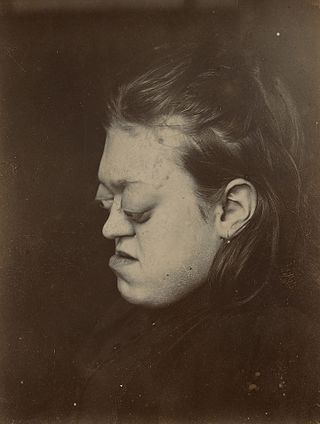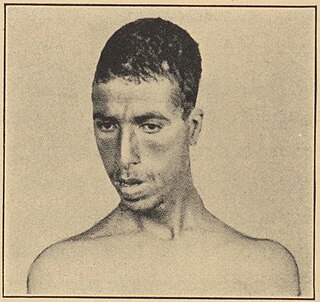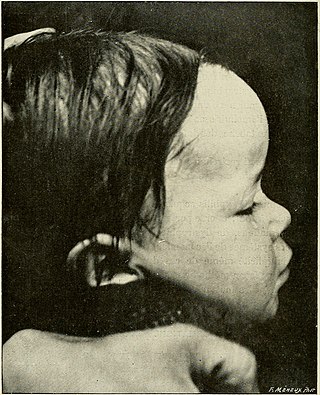
Brachycephaly is the shape of a skull shorter than average in its species. It is perceived as a cosmetically desirable trait in some domesticated dog and cat breeds, notably the pug and Persian, and can be normal or abnormal in other animal species.

Exophthalmos is a bulging of the eye anteriorly out of the orbit. Exophthalmos can be either bilateral or unilateral. Complete or partial dislocation from the orbit is also possible from trauma or swelling of surrounding tissue resulting from trauma.

Microtia is a congenital deformity where the auricle is underdeveloped. A completely undeveloped auricle is referred to as anotia. Because microtia and anotia have the same origin, it can be referred to as microtia-anotia. Microtia can be unilateral or bilateral. Microtia occurs in 1 out of about 8,000–10,000 births. In unilateral microtia, the right ear is most commonly affected. It may occur as a complication of taking Accutane (isotretinoin) during pregnancy.

Micrognathism is a condition where the jaw is undersized. It is also sometimes called mandibular hypoplasia. It is common in infants, but is usually self-corrected during growth, due to the jaws' increasing in size. It may be a cause of abnormal tooth alignment and in severe cases can hamper feeding. It can also, both in adults and children, make intubation difficult, either during anesthesia or in emergency situations.
Fryns-Aftimos syndrome is a rare chromosomal condition and is associated with pachygyria, severe mental retardation, epilepsy and characteristic facial features. This syndrome is a malformation syndrome, characterized by numerous facial dysmorphias not limited to hypertelorism, iris or retinal coloboma, cleft lip, and congenital heart defects. This syndrome has been seen in 30 unrelated people. Characterized by a de novo mutation located on chromosome 7p22, there is typically no family history prior to onset. The severity of the disorder can be determined by the size of the deletion on 7p22, enveloping the ACTB gene and surrounding genes, which is consistent with a contiguous gene deletion syndrome. Confirming a diagnosis of Fryns-Aftimos syndrome typically consists of serial single-gene testing or multigene panel of genes of interest or exome sequencing.

Pascual-Castroviejo syndrome type 1 is a rare autosomal recessive condition characterized by facial dysmorphism, cognitive impairment and skeletal anomalies.

Alwadei syndrome or autosomal recessive mental retardation-61 (MRT61) is an autosomal recessive neurodevelopmental disorder characterized by delayed psychomotor development, intellectual disability, and variable abnormal facial features. Severe patients may develop refractory seizures and have brain abnormalities, including hypoplasia of the corpus callosum. Alwadei syndrome attributed to mutation in RUSC2 gene on chromosome 9p13.3.

Microcephaly albinism digital anomalies syndrome is a very rare congenital genetic disease. The syndrome includes microcephaly, micrognathia, oculocutaneous albinism, hypoplasia of the distal phalanx of fingers, and agenesia of the distal end of the right big toe.
Blepharophimosis intellectual disability syndromes are a group of rare genetic disorders which are characterized by blepharophimosis, ptosis, and intellectual disabilities. These disorders usually follow either autosomal recessive, autosomal dominant, x-linked recessive, or mitochondrial inheritance patterns.
CHAMP1-associated intellectual disability syndrome, also known as autosomal dominant intellectual disability type 40, is a rare genetic disorder characterized by intellectual disabilities, developmental delays, facial dysmorphisms, and other anomalies.

Mandibulofacial dysostosis with microcephaly syndrome, also known as growth delay-intellectual disability-mandibulofacial dysostosis-microcephaly-cleft palate syndrome, mandibulofacial dysostosis, guion-almeida type, or simply as MFDM syndrome is a rare genetic disorder which is characterized by developmental delays, intellectual disabilities, and craniofacial dysmorphisms.

Hall-Riggs syndrome is a rare genetic disorder that causes neurological issues and birth defects. People with Hall-Riggs syndrome usually have skeletal dysplasia, facial deformities, and intellectual disabilities. Only 8 cases from 2 families worldwide have been described in medical literature. It is an autosomal recessive genetic disorder, meaning both parents must carry the gene in order for their offspring to be affected.

Severe intellectual disability-progressive spastic diplegia syndrome is a rare novel genetic disorder characterized by severe intellectual disabilities, ataxia, craniofacial dysmorphisms, and muscle spasticity. It is a type of autosomal dominant syndromic intellectual disability.

Ventricular extrasystoles with syncopal episodes-perodactyly-Robin sequence syndrome is a rare autosomal dominant genetic disorder characterized by cardiofaciodigital anomalies occurring alongside Pierre Robin sequence. Additional features include abnormal sense of smell, camptodactyly, recurrent joint dislocations, and short stature. Around 6 to 12 cases have been described in medical literature.

Narrow face is a dysmorphic feature in which its width is abnormally reduced.

Low anterior hairline is a dysmorphic feature in which the frontal hairline which defines the top and sides of the forehead is unusually low. This can mean that either the distance between the trichion (hairline) and glabella at the midline is more than 2 SD below the mean, or that this distance is apparently (subjectively) decreased.

High anterior hairline is a dysmorphic feature in which the frontal hairline which defines the top and sides of the forehead is unusually high. This can mean that either the distance between the trichion (hairline) and glabella is more than 2 SD above the mean, or that this distance is apparently (subjectively) increased.


















